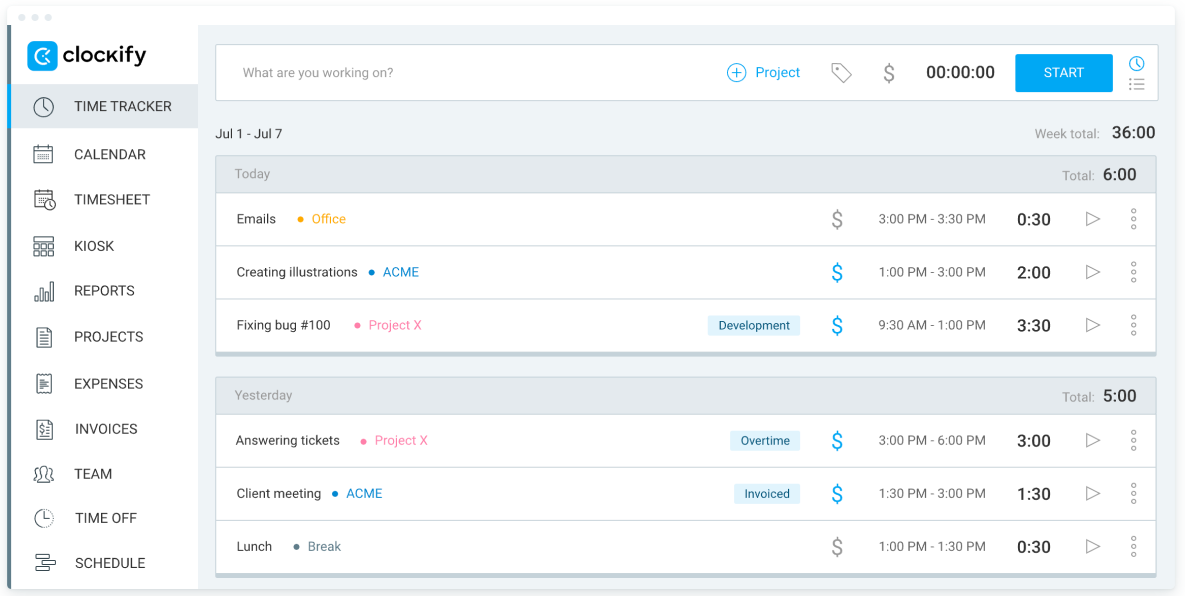On September 25, 1926, Ford Motor Company made a groundbreaking decision to introduce working from 9 to 5, 40 hours a week, with no changes in wages. Almost a hundred years later, many people consider a classic 9-5 schedule outdated, while the popularity of flex time is increasing every day.
What is flex time and why is it so appealing to so many people? We’ll try to answer those questions in this article. We’ll also talk about the advantages and disadvantages of flexible working and what you should pay attention to if you want to introduce it to your workplace.
Table of Contents
What is flex time?
According to the Department of Labor, flex time (also spelled as flextime or flex-time) is a type of work schedule that is “an alternative to the traditional 9 to 5, 40-hour workweek. It allows employees to vary their arrival and/or departure times.” Starting and ending hours are flexible, while the number of working hours per day/week is fixed. Employees on traditional schedules typically work from 9 a.m. to 5 p.m., whereas a flexible schedule can start (and end) at any time.
However, there is often a “core period” when all employees must be on the job. It creates a good balance between collaborative work and focused solo work.
For example, if the core period is from 12 p.m. to 4 p.m., you can start working anywhere from 8 a.m. to 12 p.m. — it’s just important that you’re at work 12–4 p.m.
A flex time policy is at the discretion of each business. However, flexible working might be harder for client or customer-focused employees, due to the nature of their job.
On the other hand, types of employees that can (and often do) work flex time are: freelancers, part-time workers, remote workers, healthcare workers, consultants, and creatives like writers and graphic designers.
Types of flexible working
These are some of the most common types of flexible working:
- Part-time: working less than full-time hours, typically 20-29 hours a week.
- Job sharing: an arrangement where two part-time employees split the workload, benefits, and working hours of one full-time employee.
- Remote: working from home or any other place that’s not a traditional place of work.
- Compressed hours: working full-time hours over fewer days.
- Flex time.
A flexible schedule is not one-size-fits-all. It could be:
- A fixed schedule with individualized starting and ending hours (e.g. 7 a.m. to 3 p.m.),
- A schedule with individualized starting and ending hours that vary daily (for example, working 8-4 p.m. from Monday to Wednesday and 10 a.m. to 6 p.m. on Thursday and Friday),
- A split shift, e.g. working from 7 a.m. to 12 p.m., making an extended, 3-hour lunch break, and then working 3-6 p.m.
💡 Check out another interesting type of an atypical work schedule: 9/80 work schedule: what it is and how it works.
Advantages and disadvantages of flex time
If you think about adopting the flex time business model, you should take into consideration these pros and cons.
Advantages of flexible schedules
These are the most prominent benefits of flexible working.
Increases job satisfaction
Arguably, the biggest advantage is being satisfied with your job — and, according to a workplace study by Staples Advantage, “63 percent of the happiest employees say they are able to telecommute, work flex time, or both.”
A similar conclusion can be found in a Forbes article: “Research (our own and others) shows that employees are healthier, experience less stress, and are more productive and engaged when they effectively make choices about how, where, and when they work. One way to do this is by responding to individual ‘work styles’.”
Boosts productivity
Choosing your own hours is the perfect opportunity to work in tune with your circadian rhythm. For a lot of people, periods of high alertness and wakefulness are in the late morning and late afternoon, while energy levels are lower in the early afternoon.
It doesn’t have to be like that — some people are at their most productive state early in the morning or late at night. Flex time allows you to work at the time of the day when you’re the most efficient, thus increasing your productivity.
Gives more freedom and flexibility
You have more time for things outside of work that are important to you; you also don’t have to sacrifice your personal life for work obligations.
Helps you avoid rush hour
If you have to commute to get to work, traffic won’t be as big of an issue as it would be if you worked 9-to-5. Choosing your own schedule means that you can go to work a little earlier or later than the majority and avoid the rush hour.
It’s helpful for parents
If you’re a parent, getting ready in the morning can get hectic — but having a flexible schedule can make your life much easier. You can help your children get ready, make them breakfast, or give them a ride to school without rushing and wondering if you’ll manage to be in the office on time.
The same goes for picking them up from school, coming to their soccer games, or being able to work from home when they’re sick.
Decreases absenteeism
Flexible scheduling can reduce absenteeism, as employees are less likely to arrive late or call in sick. It also allows them to complete all personal obligations they may have during the day, while still working their regular number of hours.
Greater cost-efficiency
Flexible working allows you to save money in many different ways, from spending less on electricity bills to buying fewer office supplies. When fewer people are coming to the office, you can rent a smaller office and spend less money on rent.
Moreover, higher job satisfaction (that we discussed earlier in the article) means higher employee retention.
Disadvantages of flexible schedules
Flex time also has some downsides.
Can be isolating
To some people, spending time alone and working by yourself is as close to paradise as it gets. To others, it can be quite isolating and negatively affect their mental health.
Can be complicated to coordinate and schedule meetings
Determining when every employee works can be quite time-consuming. If everyone’s schedule is different, finding a time that works for everyone can be next to impossible.
It’s harder to monitor overtime hours
With so many different schedules in the equation, it can be difficult for managers to keep track of everyone’s overtime work. That can turn into a problem when it comes time to get paid for those extra hours.
💡 If these disadvantages make you prefer working 9-to-5, learn How to make an 8-hour workday schedule work.
Work-life balance with flex time
What is work-life balance like when you’re working flexible hours? Either really good or really bad, depending on the circumstances — hence it is its own category.
On one hand, you are able to choose your own hours and make the optimal schedule. That allows you to be in tune with your natural rhythm and make time for everything important to you. It reduces stress and it’s good for your overall health.
On the other hand, you can end up getting many important emails and messages before and after your working hours. Since there’s always someone working, there’s always something going on. That creates an “always-on” mentality and leads to burnout.
If you’re working flexible hours, do your best to work only during your working hours, not the whole day. It’s easy to get caught up in work, but it’s crucial to have a balance.
Advice for successfully adopting flexible working
You decided that the pros outweigh the cons and you want to include flex time in your business model? Here are some tips to make that change as smooth as possible.
Have good communication
The process of adopting the flex time model should include addressing everyone’s concerns and questions, as well as jointly resolving any issues that may occur.
But open communication shouldn’t stop there — when your team is virtual, frequent and transparent communication is a must. In their book, Effective Public Relations, professors at the University of Wisconsin Scott M. Cutlip and Allen H. Center defined 7 C’s of effective communication:
- Completeness,
- Conciseness,
- Consideration,
- Concreteness,
- Courtesy,
- Clearness,
- Correctness.
Make the most out of tools
To have a clear overview of everyone’s schedule and the number of hours worked, it’s best to use a time tracker such as Clockify. It may take a few minutes out of your day, but it will leave no room for any confusion and misunderstandings.
If you want to go an extra mile and ensure everyone’s always on the same page even with flexible work hours, you can always opt for a set of productivity tools designed with every work schedule in mind.
This way, you’ll be able to communicate with your teams smoothly, assign tasks and stay on top of everyone’s hours within seconds.
Include flex time policy in the employee handbook
A flex time policy consisting of specific rules relevant to your company should be your top priority when implementing a flex time work schedule.
However, before you add your flex time policy to the employee handbook, make sure it includes:
- Reasons and objectives for flexible working,
- Different types of flexible scheduling offered,
- Conditions that need to be met to qualify for flex time (if there are any),
- Instructions on how to request and use flex time — can employees choose their working hours and place of work every day, or do they need to submit a request in advance?
Track employee time and attendance with Clockify
Whether your employees are working on a fixed or flexible schedule, tracking their time and attendance is crucial for any business.
One of the best ways to track your employees’ work hours and attendance is by using an employee time and attendance software such as Clockify.
Clockify lets you record your and your employees’ work hours via timer in real time or add it manually using timesheets.

After your employees start clocking in, you can check their attendance in Clockify by going to the Reports section and clicking on the Attendance tab.

There, you can see your team’s daily work hours, breaks, overtime, capacity, and even time off. This way, you’ll know exactly how much time they spent on work, as well as when they were present or absent.
If you need a tool to keep track of your employees’ work hours and attendance but also create time off policies, track billable hours, and more, Clockify is the right solution for you.


